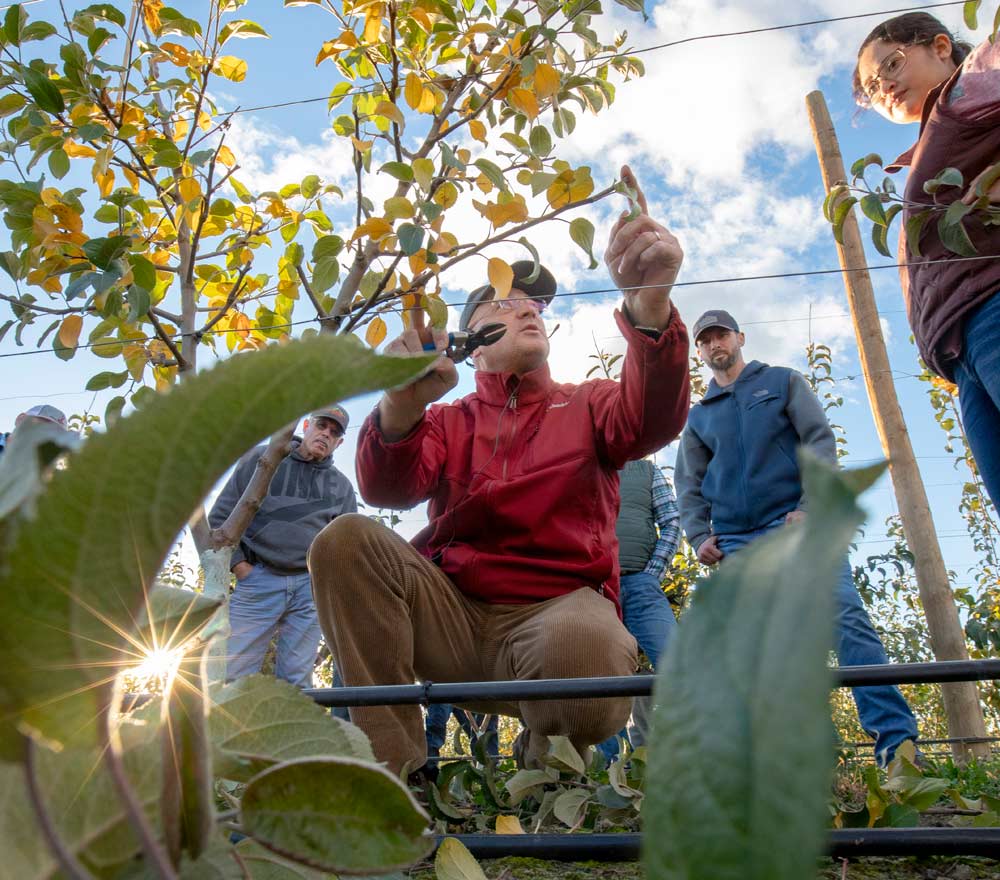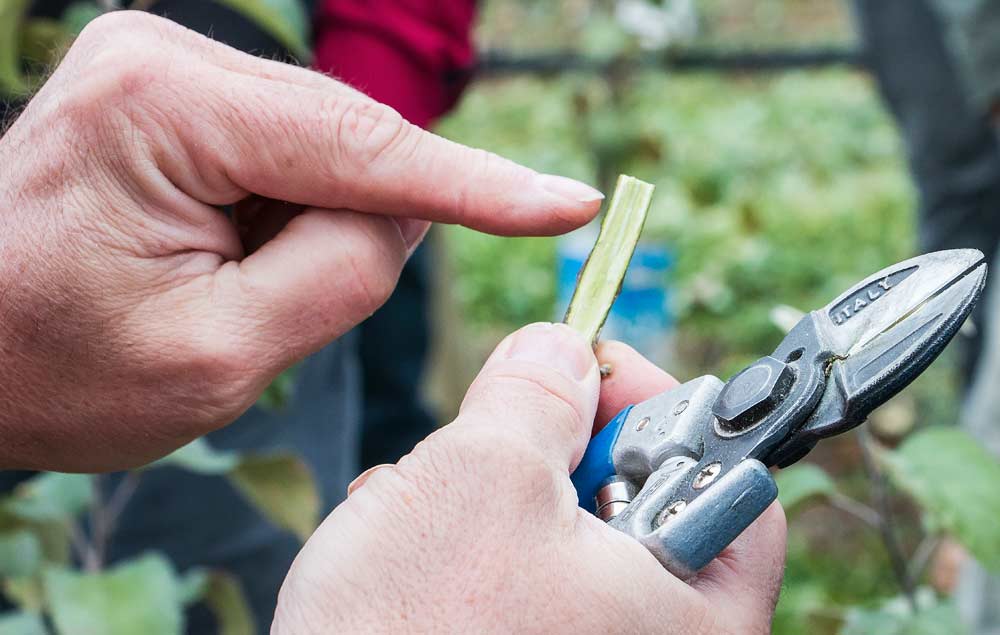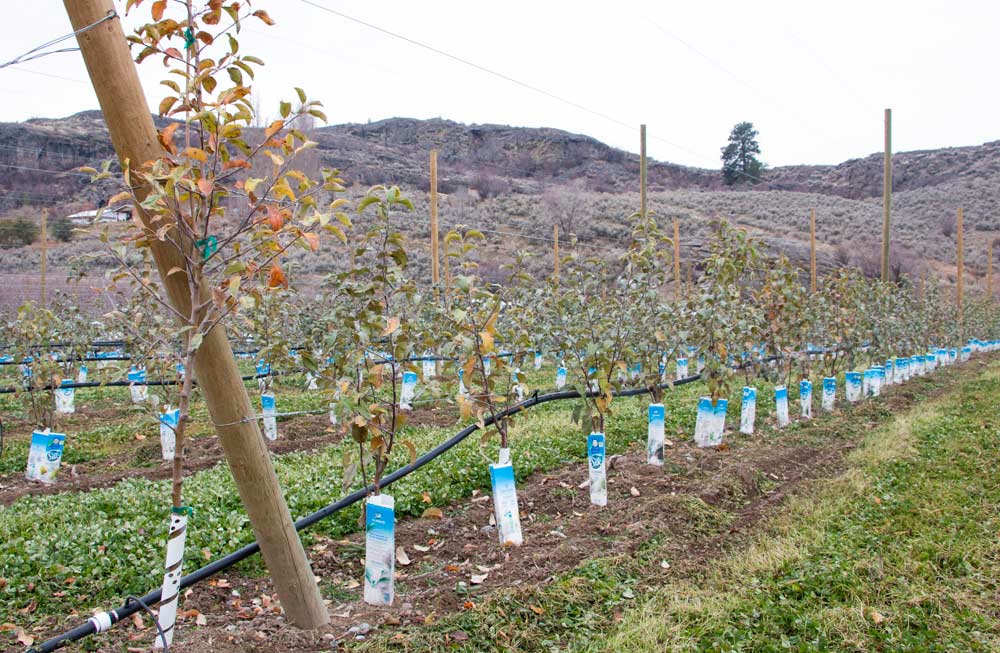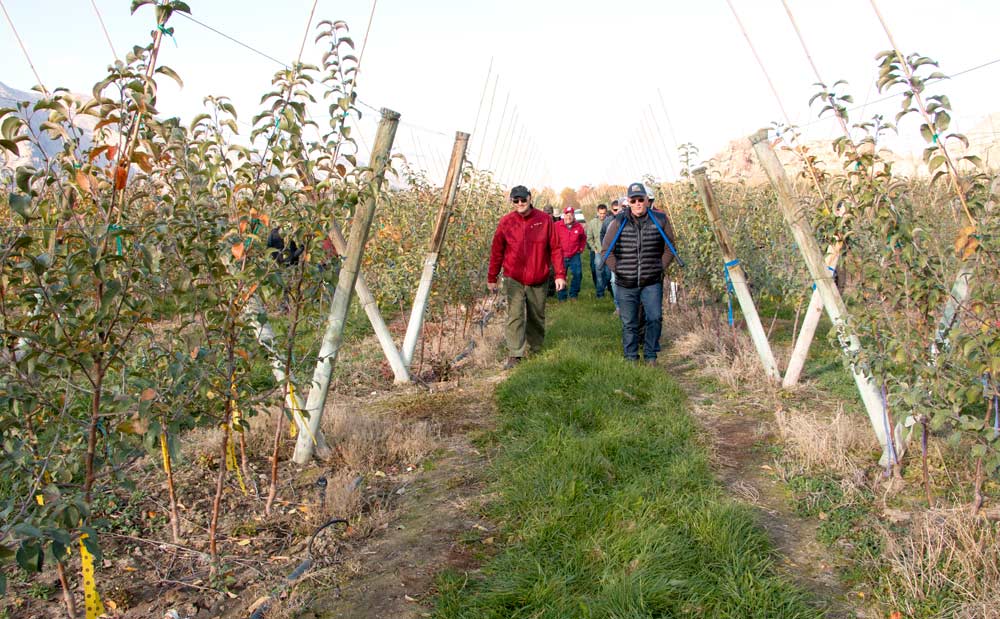
Across Washington, growers are eager to get their new WA 38 orchards to bear highly anticipated fruit. So, it can be hard to watch Washington State University horticulture professor Stefano Musacchi take pruners to every flower bud-bearing shoot tip on a young tree as he demonstrates the winter pruning techniques he believes will best set the blind wood-prone variety up for long-term success.
“First you build your tree, then you start to crop,” he said. WA 38 is a tip-bearing variety, and leaving those apical flower buds can blind the developing scaffolds. “At the beginning, the goal is to prevent blind wood,” he said. “You want to fill the space with productive wood.”
To do that, he recommends click pruning, scoring and keeping the tree in balance to promote a strong fruiting structure in years to come.
Click pruning is a short pruning technique designed to promote renewal of fruiting wood and light interception in high-density canopies. Unwanted branches are headed back to leave just two or three buds to spur vigorous new growth, rather than cut off flat.
Scoring encourages new shoot development. Musacchi recommends teaching crews to use a light hand and angled pruners to score a shallow spiral cut, rather than a 360-degree cut that will put the young limbs at risk of snapping. It’s best done as buds swell in February or March and can be followed with Promalin (gibberellic acid and benzyladenine).
No matter the system, for the most productive growth, Musacchi said it’s important to keep the young WA 38 trees in balance as they grow into their space. Large branches up high will compete with and stunt the axis. Lower on the tree, leave branches with the best angles and remove their competitors.
“I’m always looking for the bud below that will give me a horizontal shoot,” Musacchi said as he used the click pruning approach on scaffold branches.
These principles — seeking balance and minimizing blind wood with click pruning and scoring — are implemented differently, depending on the vigor of the trees as driven by rootstock, site and planting system, Musacchi explained on November tours of WA 38 orchards across the state.
Washington growers have a 10-year head start on the variety over other domestic apple growers. Day one of the tour took place in Central Washington’s Yakima Valley, followed by a second day in WSU’s Sunrise research orchard near Wenatchee and a third day in the north-central region of the state. Here, Good Fruit Grower has a recap of the highlights:
Tieton: Spurring growth
West of Yakima, near the small town of Tieton, trees planted on Bud. 118 and EMLA 111 rootstocks were still quite small after their first season and Musacchi urged aggressive click pruning to drive more vigorous growth next season.
Many of the trees had also been clipped at the top at planting, a practice that can spur vigor but which Musacchi cautions against for WA 38. Growers should protect that vertical growth instead.
“I don’t like the heading cut because usually you get a strong reaction of shoots to replace the leader,” he said. “It’s too dramatic. I like the scoring to promote shoots better.”
Under Musacchi’s watchful eye, grower Jan Strand Selby tried to mimic his pruning style, allowing tour attendees to learn with her as she put his principles into practice.

“I’m very conservative because you can’t put it back,” she said, “but you are going to make me be brave, aren’t you?” Cautious at first, she got the hang of the technique, selecting branches to remove with a click cut and tipping back the shoots she wanted to keep. “We’re not going to crop this next year, so we want to spend the next year growing the trees,” she said.
Selah: Variable vigor
In vigorous conditions, however, leaving some flower buds to set fruit can help slow the trees down. That’s the case in a Monson Fruit orchard northwest of Yakima, in Selah, where WA 38 on Geneva 41 rootstock had just one wire left to go on its trellis.
“These trees can carry 15 to 16 apples if you want to shut down the growth,” Musacchi said, estimating the crop load for the upcoming season based on four fruits for each centimeter of tree cross-sectional area. But that crop should be kept low in the tree, not on the upper axis. “If you want to fill more space, don’t do it,” he said.
In an adjacent block planted on Malling 9 Nic.29, the trees were smaller but in a better balance, and Musacchi advised against early cropping. Same in a block on G.935 rootstock, where he demonstrated how to restart a tree for a better structure. He tackled a tree with big branches high and none below and click pruned everything back.
“You really want to use that second year to build a better tree,” he said, acknowledging that such aggressive pruning can be a bit scary. “But it’s not like a Honeycrisp that shuts down. This variety grows.”
Zillah: Scoring
There’s still a lot of space to fill in a Zillah orchard where two-leader trees planted on M.9-337 are trained to a V-trellis. Yakima Fruit and Cold Storage orchard manager Rob Ritchie explained that one block was trained with the tree canopy perpendicular to the trellis, while the other was trained in parallel.
Two leaders is a good choice for the vigorous WA 38, Musacchi said, but growers should be careful not to pull branches down to tie them to the trellis, as such bending can cause the limbs to go blind. Instead, branches that come up from a 45-degree crotch angle can be tied down.

Scoring will be very beneficial to filling out this fruiting wall canopy, but not on 1-year-old wood or very slim leaders, which could create a breakage risk.
“Here, you don’t want to crop for a couple years while you complete the structure because you have a lot of space to fill,” Musacchi said.
Sunnyside: Options
At another two-leader system at a Kershaw Fruit orchard in Sunnyside, trees planted on G.890 showed a lot more vigor. Trained to a vertical trellis, the trees were quite branchy in the lower canopy — a good candidate for click pruning.
The first priority for pruning is to remove any large branches that compete with the leaders. In fact, those big competitors should be taken out as soon as possible, preferably with a quick summer pruning pass.
Branches that were too vertical were stubbed back at a bud that will grow horizontally and branches that offer good scaffolding were just headed back slightly to remove flower buds and apical dominance.
“Try to make a really good skeleton of the tree at the beginning,” Musacchi said. While few interior branches are desirable, leaving stub cuts with a few buds, rather than making a flat cut to remove unwanted branches, is an insurance policy in the face of blind wood, Musacchi and grower Dave Gleason agreed.
An adjacent block planted on G.969 was a little less vigorous, so Musacchi suggested slightly more aggressive pruning. But he cautioned against scoring the skinny leaders until the second leaf.
Tonasket: Deer woes
Grower Sam Godwin planted WA 38 on G.935 last spring. Trees planted at the ends of the rows, outside the trellis, had grown tall on a single leader by November, while trees that had been headed back along the trellis, to create two leaders, remained short.
Godwin said he chose G.935 because he wanted something replant-resistant on the old orchard site and suitable for gravelly soil. He also said he recognized that heading back the trees to go two-leader meant losing a year, but he only aims to take those to about the 6-foot mark on his trellis.

“I wanted to double my growing points and halve my number of trees,” he said. “So, I was doing a trade, getting more growing points with less dollars per tree.”
The ideal two-leader orchard has 30 inches between trees, with 15 inches between each leader, Musacchi said. “The bi-ax is something to consider when you have excellent vigor, not when you have low vigor,” he said. “Check your soil composition and rootstock, then decide if you want to go bi-ax or not.”
In addition, if growers want to head back their trees, it’s better to have at least a nine-month tree, such as a bench graft tree, because the wood is young and the trees can have a better result. “But it’s also true, that despite everything, you got a good result there,” he told Godwin.
The bigger issue: deer damage, or specifically, deer creating unwanted laterals in his trees.
“The deer have been click pruning for you,” Musacchi joked. Godwin replied, “Yes, but we haven’t been able to train them to do the whole job. They’re not precision.”
Musacchi noted that growers can head back trees lower, 45 to 50 days after planting. “That way, if you do your sinks earlier, your tree will be bigger and will push more,” he said. “In some cases, if you don’t make the selection early, you are slowing the tree.”
Of course, Musacchi acknowledged that he’s talking about a perfect world, with no deer. As WSU tree fruit extension specialist Karen Lewis noted, if Godwin has deer damage and delays heading and, later, pruning — and then the deer eat one lateral — he’ll still have additional choices remaining and be OK.
Orondo: Testing rootstocks
At Rocky Road Orchards, grower Tom Auvil has planted single-leader trees in a short V, 2D system on three different rootstocks: G.890 as feathered trees, G.41 as finished trees, and G.969 as 7/16th whips.
Some of the latter trees had grown tall, up to the 3-foot wire without branching and might require scoring below the wire and click pruning. “An astute grower probably would have tipped those in July,” Auvil quipped. “That’s one reason these are all single axis. The double axis requires more diligence than is available on this orchard.”
On the G.969 trees, Auvil said he planned to tell workers to use hand clippers to take off strong leaders growing inside the V, and likely will do the same in the G.41 block. The G.890s, however, probably won’t be pruned that vigorously, he said, in order “to keep them as calm as we can.”
Auvil said they’re going to have to fix their biological pruning in the whole block. “We’ll probably have to prune some of those back harder,” he said. “We may take strong shoots back to a spur due to deer grazing.”
So which rootstock is proving to be best?
“I guess this is the demonstration where we’re trying to figure that out,” Auvil said.

Some people have walked away from G.41 and moved to G.11, which has two issues of its own, he noted: It’s not woolly aphid tolerant and it’s not consistent in vigor across soil textures. “It wouldn’t do well in the sandy end of the block here,” he said.
So far, G.41 and G.890 have been consistent across soil types, which is important in the valley floors where soil texture changes frequently, he said. Overall, growers should be testing at least two, perhaps three, rootstocks on their own sites to determine what will work best.
Lewis noted that as well: “You can farm the same rootstock to different soils or plant different rootstocks, but you can’t do either if you’re not paying attention.”
East Wenatchee: Going organic?
At Legacy Orchards, a second-leaf block of WA 38 on G.41 was planted with every other tree leaned on a V-trellis. Grower Scott McDougall used to plant everything vertically on a 3-foot by 10-foot spacing, but several years ago shifted to 2-by-12 on a steep V, with a 10-degree angle.
He recognizes he will have to pick in the center with this system in the future, but he’s also doing some experimenting with four leaders, two to a side.
Musacchi noted that pears are grown with four stems on vigorous rootstocks in Italy, and they grow very well. “I like it, as long as you keep the inside clean,” Musacchi said. “But you can really fill up the space with short branches.”
McDougall aims to convert the block to organic, a move that could play out well with four leaders, Musacchi said.
“If you’re going organic and don’t have the tools available to shut down the vigor on the tree, that is a good option,” he said. •
—by Kate Prengaman and Shannon Dininny






Leave A Comment